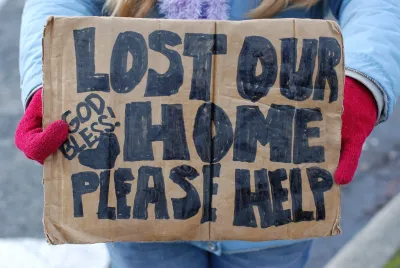Projects to add housing resources to help give homeless people a roof over the head have run into all sorts of public opposition—often times fueled by ignorance of how different kinds of homeless housing options work.

An article and video by Lisa Halverstadt explain the differences in the kinds of homeless housing to counter the confusion that sometimes fuels community opposition to projects intended to assist homeless populations.
"Exhibit A: Residents and even news outlet KUSI recently wrongly declared that the city was proposing a homeless shelter in Mission Hills, when the project is actually something else entirely," writes Halverstadt.
Halverstadt lists four kinds of homeless housing: 1) Homeless Shelters, 2) Transitional Housing, 3) Permanent Housing, and 4) Affordable Housing.
It might be surprising to see affordable housing included on the list, but there is evidence that a lack of affordability in the housing market is contributing to the homeless crisis in expensive cities. Halverstadt makes the case that when people can afford housing, they are no longer homeless, which is exactly the point.
The video below also offers Halverstadt a chance to explain clearly the distinctions between the kinds of housing that can help homeless people, and why those distinctions matter.
VOSD's @LisaHalverstadt explains four different types of housing for homeless residents in less than two minutes.
More info here: https://t.co/hB8gfCR4BP pic.twitter.com/sLy5NGz2dG— Voice of San Diego (@voiceofsandiego) July 10, 2019
FULL STORY: What We Mean When We Talk About Housing the Homeless

National Parks Layoffs Will Cause Communities to Lose Billions
Thousands of essential park workers were laid off this week, just before the busy spring break season.

Retro-silient?: America’s First “Eco-burb,” The Woodlands Turns 50
A master-planned community north of Houston offers lessons on green infrastructure and resilient design, but falls short of its founder’s lofty affordability and walkability goals.

Delivering for America Plan Will Downgrade Mail Service in at Least 49.5 Percent of Zip Codes
Republican and Democrat lawmakers criticize the plan for its disproportionate negative impact on rural communities.

Test News Post 1
This is a summary

Test News Headline 46
Test for the image on the front page.

Balancing Bombs and Butterflies: How the National Guard Protects a Rare Species
The National Guard at Fort Indiantown Gap uses GIS technology and land management strategies to balance military training with conservation efforts, ensuring the survival of the rare eastern regal fritillary butterfly.
Urban Design for Planners 1: Software Tools
This six-course series explores essential urban design concepts using open source software and equips planners with the tools they need to participate fully in the urban design process.
Planning for Universal Design
Learn the tools for implementing Universal Design in planning regulations.
EMC Planning Group, Inc.
Planetizen
Planetizen
Mpact (formerly Rail~Volution)
Great Falls Development Authority, Inc.
HUDs Office of Policy Development and Research
NYU Wagner Graduate School of Public Service





























